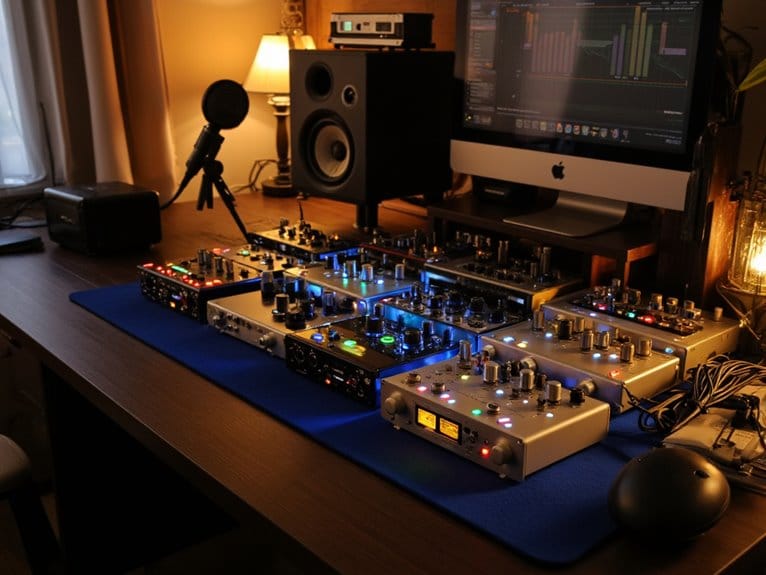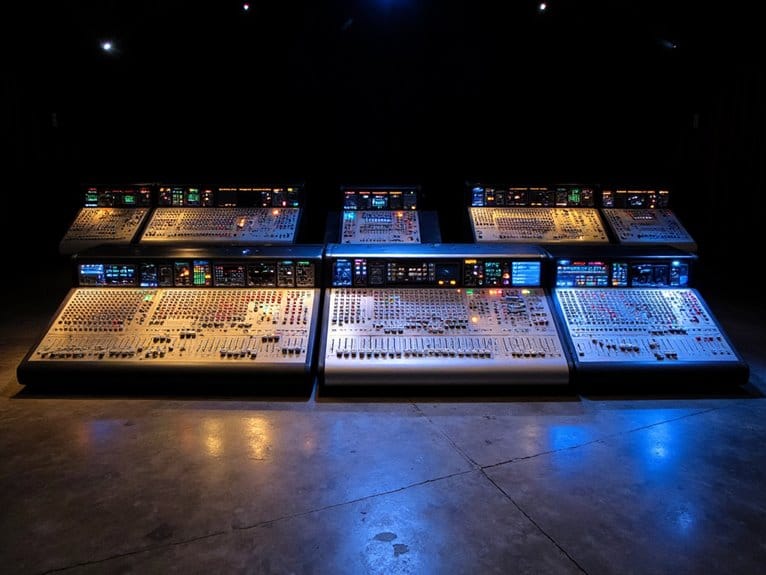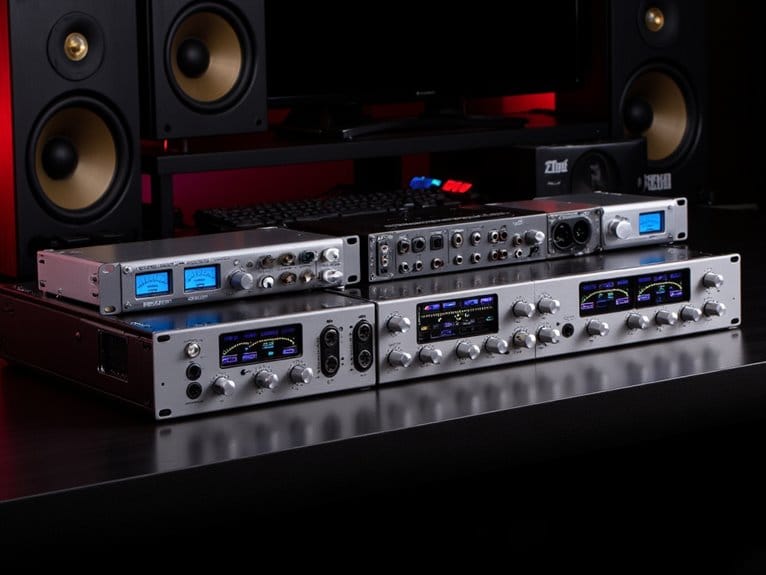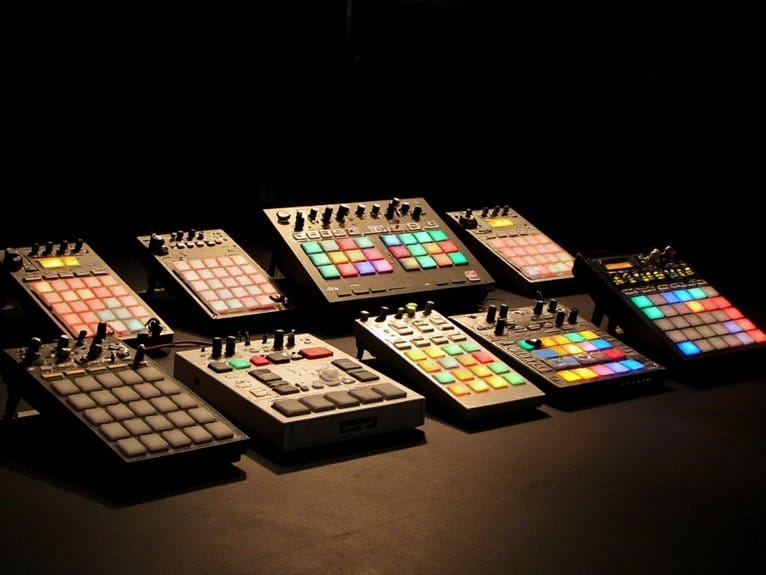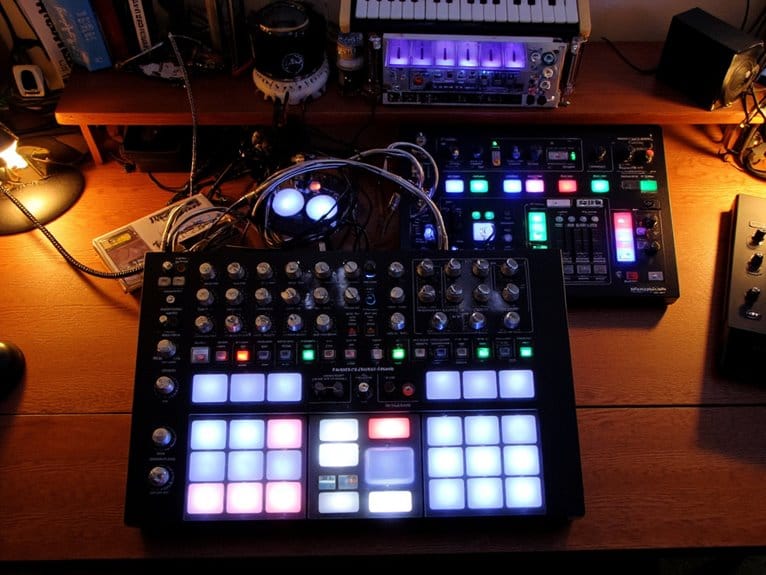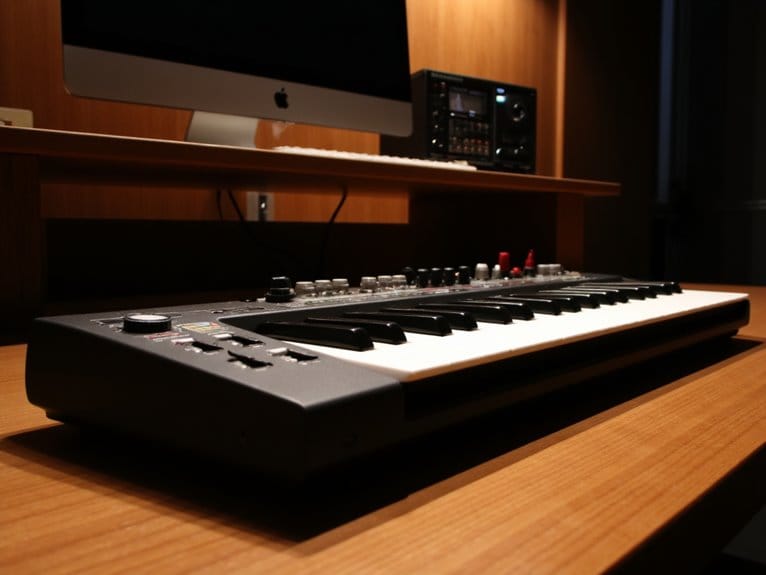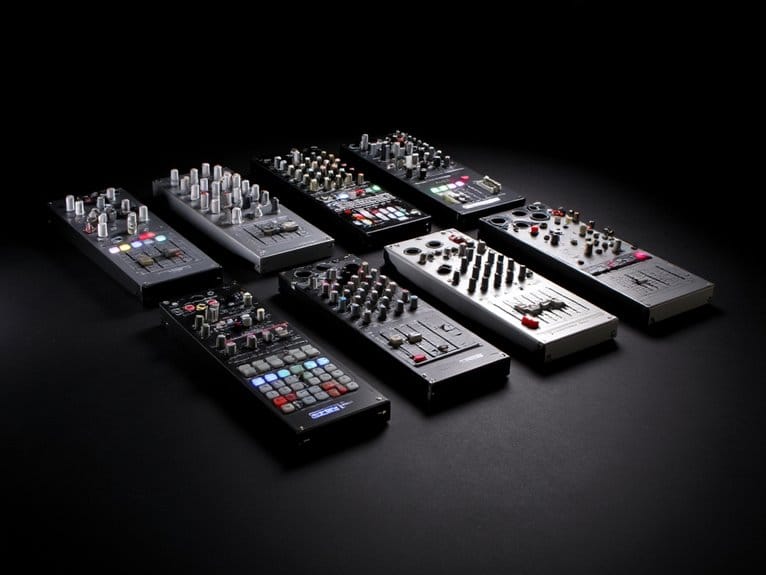Best Mac Audio Interfaces for Professional Recording
After testing dozens of Mac-compatible audio interfaces this year, I’ve found the Focusrite Scarlett 18i20 leads with exceptional 24-bit/192 kHz resolution and extensive 18-input connectivity, while the MOTU UltraLite-mk5 impresses with upgraded preamps delivering +74 dB gain and built-in streaming capabilities. Budget-conscious producers gravitate toward the Behringer UMC404HD at $99, featuring Midas preamps and MIDI I/O, though the portable M-Audio M-Track Duo excels for mobile recording at just 12.7 ounces. Below, you’ll discover detailed specifications and performance insights for each interface.
We are supported by our audience. When you purchase through links on our site, we may earn an affiliate commission, at no extra cost for you. Learn more.
Notable Insights
- Top Mac audio interfaces feature 24-bit/192 kHz resolution with high-quality AD/DA converters and dynamic ranges exceeding 110 dB.
- Professional models offer comprehensive connectivity including multiple XLR/TRS combo inputs, MIDI I/O, and balanced outputs for studio flexibility.
- Compact, portable designs with plug-and-play Mac compatibility enable seamless mobile recording and home studio setups.
- Included software bundles valued over $1,000 provide popular DAWs like Pro Tools and Ableton Live for immediate professional use.
- Budget-friendly options like Behringer UMC404HD at $99 deliver professional-grade features without compromising recording quality or performance.
Focusrite Scarlett 18i20 USB-C Audio/MIDI Interface (4th Generation) Bundle
The Focusrite Scarlett 18i20 (4th Generation) stands as a powerhouse solution for Mac users who demand professional-grade recording capabilities without the complexity that often accompanies high-end audio interfaces. You’ll appreciate the eight ultralow-noise microphone preamps delivering up to 69 dB gain, paired with RedNet 24-bit/192 kHz AD/DA converters that provide an impressive 122 dB dynamic range for crystal-clear recordings. The Auto Gain mode automatically adjusts recording levels while Clip Safe prevents signal distortion, making this interface particularly forgiving for less experienced users who’re still learning proper gain staging techniques.
Best For: Professional musicians, producers, and content creators who need a high-quality multi-input audio interface for recording bands, podcasts, or complex audio setups with multiple microphones and instruments.
Pros:
- Eight ultralow-noise preamps with 69 dB gain and professional RedNet converters deliver studio-quality recordings with 122 dB dynamic range
- Auto Gain and Clip Safe features make it beginner-friendly while maintaining professional capabilities
- Comprehensive connectivity with 18 inputs, 20 outputs, dual headphone outputs, and compatibility across Mac, Windows, Chromebook, and iPad
Cons:
- Requires external power supply, limiting portability compared to bus-powered interfaces
- Large form factor (20.25 x 15.38 x 5.75 inches) and 14.62-pound weight make it unsuitable for mobile recording
- Higher price point may be excessive for solo musicians or simple recording setups that don’t need multiple inputs
PreSonus AudioBox 96 25th Anniversary USB Audio Interface
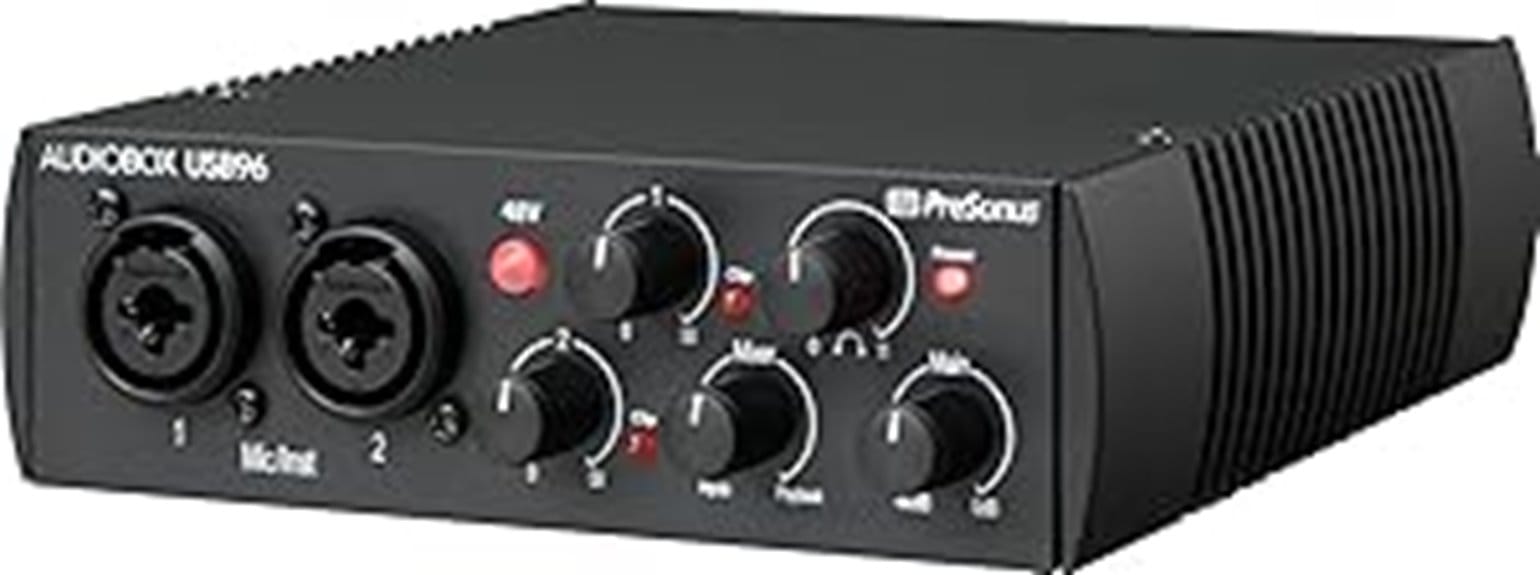
Budget-conscious creators who need professional recording capabilities without breaking the bank will find their perfect match in the PreSonus AudioBox 96 25th Anniversary USB Audio Interface, a compact powerhouse that delivers studio-grade performance at an accessible price point. You’ll appreciate the 2 Class-A mic preamps, high-headroom instrument inputs, and 24-bit/96 kHz converters housed within a rugged steel chassis measuring just 5.5 x 5.5 x 1.75 inches. The USB bus-powered design eliminates adapter clutter, while over $1000 in bundled software, including Studio One Artist and Ableton Live Lite, provides immediate creative possibilities for Mac users.
Best For: Budget-conscious creators, singer/songwriters, podcasters, and musicians who need professional recording capabilities in a portable, affordable interface without sacrificing sound quality.
Pros:
- Studio-grade 24-bit/96 kHz converters and Class-A mic preamps deliver professional audio quality at an accessible price point
- USB bus-powered design with compact steel chassis makes it ideal for mobile recording without needing external power supplies
- Includes over $1000 worth of professional software including Studio One Artist and Ableton Live Lite for immediate creative possibilities
Cons:
- Limited to only 2 inputs, which may be restrictive for larger recording projects or band setups
- Some users have reported compatibility or operational issues based on customer feedback
- No onboard DSP effects or advanced routing capabilities found in higher-end interfaces
FIFINE Gaming Audio Mixer with XLR Microphone Interface (SC3)
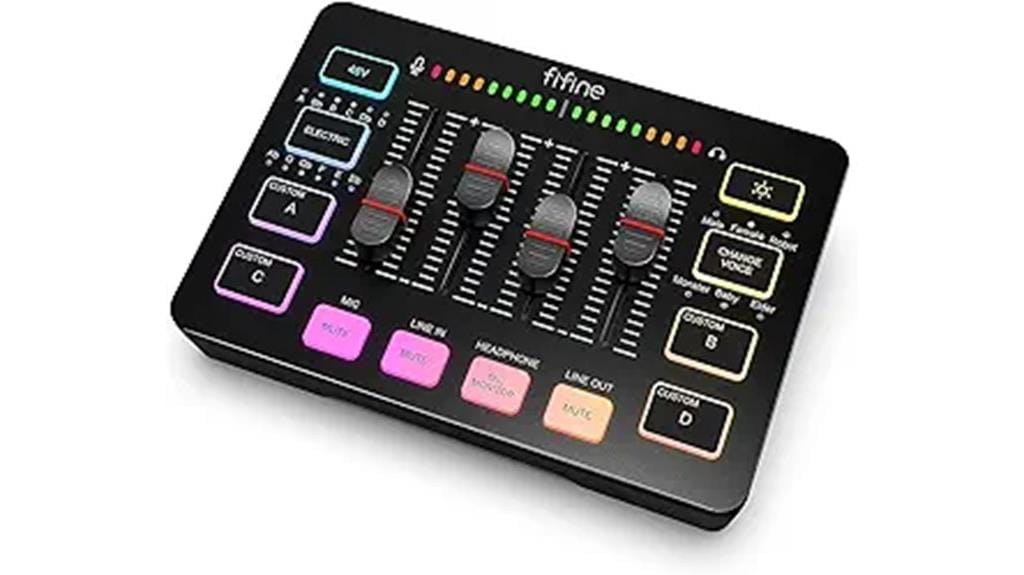
Gaming enthusiasts and streaming newcomers will find their perfect entry point with the FIFINE SC3, a compact audio mixer that transforms basic setups into professional-sounding productions without breaking the bank. This mixer delivers XLR microphone support with 48V phantom power, four individual channel controls, and customizable sound effects that’ll make your streams more engaging than my first attempts at live recording. The RGB lighting adds visual flair without overwhelming your setup, while the plug-and-play Mac compatibility makes installation remarkably straightforward. Though the plastic construction feels less premium than pricier alternatives, the SC3’s real-time monitoring and zero-latency performance prove that effective audio processing doesn’t require mortgage-level investments.
Best For: Gaming enthusiasts, streaming newcomers, and content creators seeking an affordable entry-level audio mixer with XLR microphone support and customizable sound effects.
Pros:
- XLR microphone input with 48V phantom power and real-time monitoring for zero-latency audio control
- Four individual channel controls with customizable sound effects, voice changing modes, and auto-tune options
- Plug-and-play compatibility with Mac and Windows systems plus attractive RGB lighting for visual appeal
Cons:
- Plastic construction feels less durable and premium compared to higher-end alternatives
- Lacks modern features like Bluetooth connectivity and sidechain support
- Not compatible with USB microphones, limiting flexibility for some setups
MOTU UltraLite-mk5 USB-C Audio/MIDI Interface (8453) Bundle
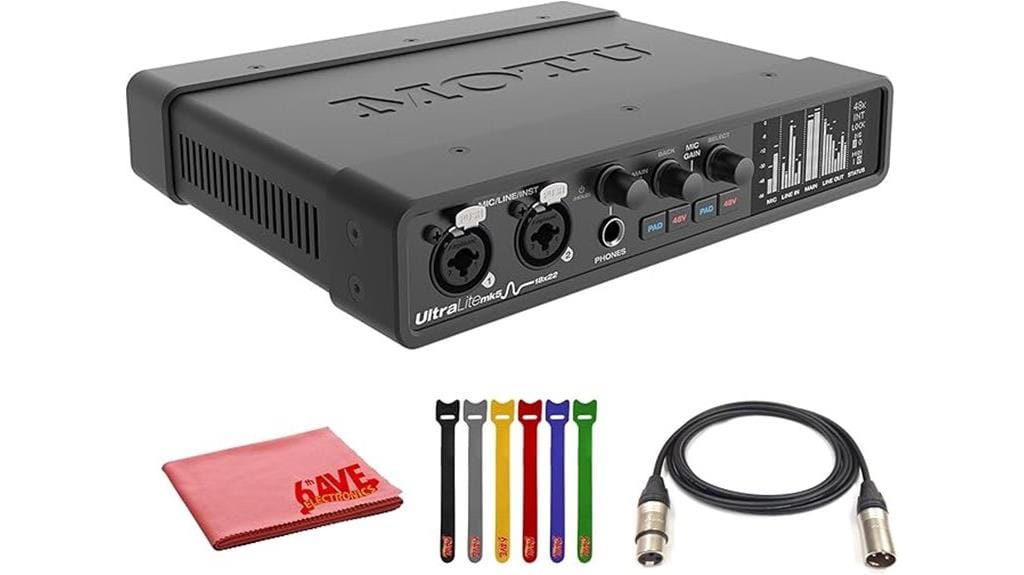
Professional studios and content creators who refuse to compromise on audio quality will find their match in the MOTU UltraLite-mk5 USB-C Audio/MIDI Interface, a powerhouse that delivers 18 inputs and 22 outputs in a surprisingly compact package. With upgraded mic preamps providing +74 dB gain and ultra-low noise, this interface handles everything from delicate vocal recordings to hot instrument signals without breaking a sweat. The ESS Sabre32 DAC delivers an impressive 125 dB dynamic range with -114 dB THD+N, ensuring your mixes translate accurately across different playback systems. Built-in loopback channels support modern workflows like podcasting and livestreaming, while the rugged construction means you can confidently take this interface from studio to stage.
Best For: Professional studios, content creators, podcasters, and musicians who need high-quality audio recording with extensive I/O options in a portable interface that can handle complex recording and streaming workflows.
Pros:
- Exceptional audio quality with ESS Sabre32 DAC delivering 125 dB dynamic range and upgraded mic preamps with +74 dB gain
- Comprehensive connectivity with 18 inputs and 22 outputs including optical ADAT, S/PDIF, and MIDI I/O for versatile studio setups
- Modern workflow support with built-in loopback channels for podcasting and livestreaming, plus cross-platform compatibility
Cons:
- Higher price point may be prohibitive for beginners or basic home recording setups
- Complex feature set requires a learning curve to fully utilize all capabilities
- Relatively heavy at 5.3 pounds for those prioritizing maximum portability
Focusrite Scarlett Solo 3rd Gen USB Audio Interface
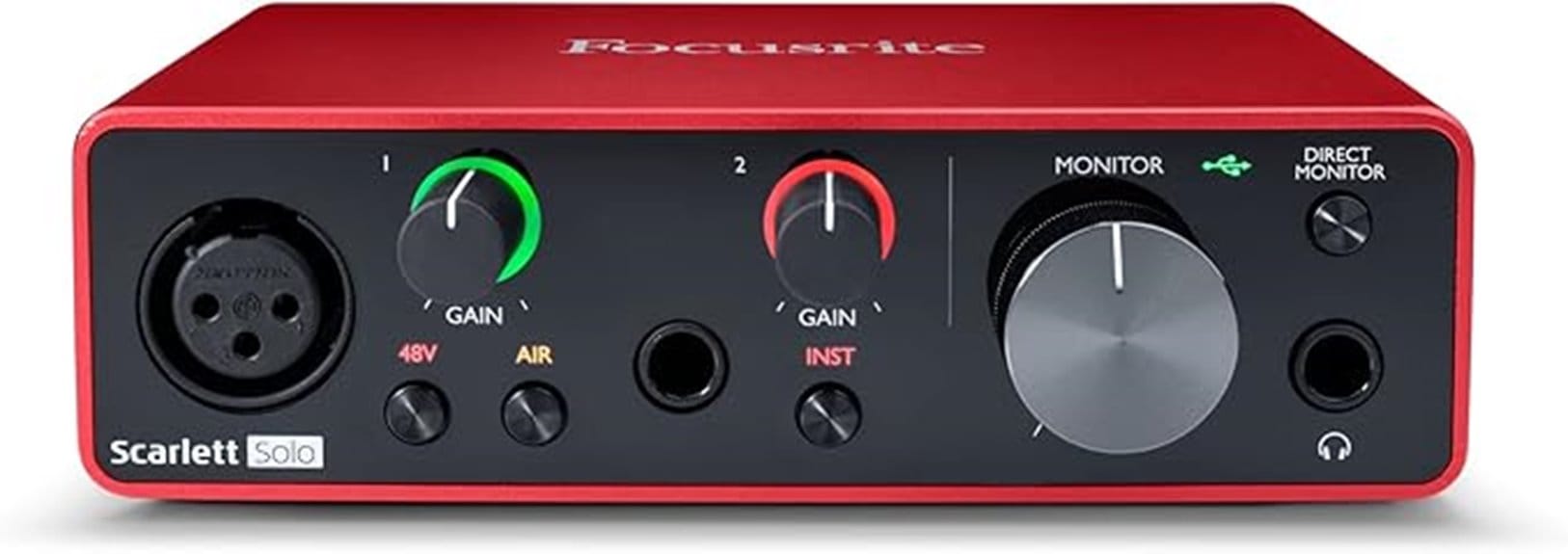
The Focusrite Scarlett Solo 3rd Gen stands as my top recommendation for solo creators who demand studio-quality recordings without the complexity of multi-input interfaces, offering a streamlined approach that transforms your Mac into a professional recording station with remarkable simplicity. You’ll appreciate the high-performing mic pre-amp with switchable Air mode, which adds that coveted brightness to acoustic recordings, while the dual high-headroom instrument inputs accommodate guitars and bass without unwanted clipping. The intuitive Gain Halos provide visual feedback—green means you’re good, red signals trouble—making level monitoring effortless even for beginners. Recording capabilities reach 24-bit/192kHz resolution through premium converters, ensuring your productions maintain professional standards that rival expensive studio setups.
Best For: Solo creators, guitarists, vocalists, podcasters, and producers who need studio-quality recording capabilities with a simple, single-input setup for Mac or PC.
Pros:
- High-quality audio recording up to 24-bit/192kHz with professional-grade converters and low-noise balanced outputs
- User-friendly design with intuitive Gain Halos for easy level monitoring and switchable Air mode for enhanced acoustic clarity
- Excellent value with bundled software including Pro Tools Intro+, Ableton Live Lite, and FL Studio Producer Edition
Cons:
- Limited to single input recording, making it unsuitable for multi-instrument or band recording sessions
- Initial setup can be challenging for beginners, requiring driver installation and input/output configuration
- Lacks multiple input options that more advanced users might need for complex recording scenarios
M-Audio M-Track Duo USB Audio Interface for Recording & Podcasting
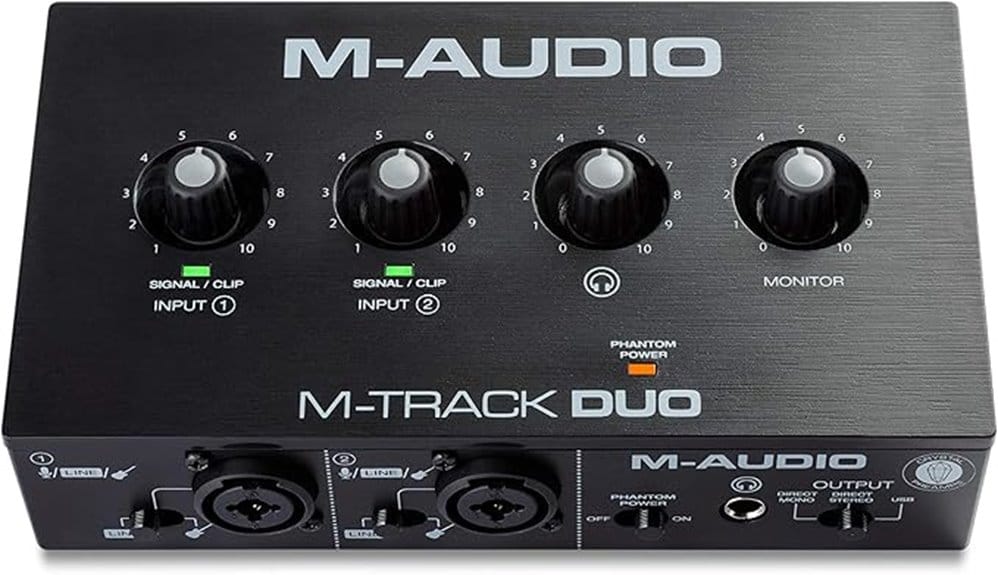
Compact versatility defines the M-Audio M-Track Duo USB Audio Interface, a streamlined solution that’s particularly well-suited for podcasters, home studio enthusiasts, and mobile musicians who need professional-quality recordings without the complexity of larger interfaces. You’ll find dual combo XLR/line/instrument inputs with phantom power, enabling compatibility with virtually any microphone or instrument you throw at it. The 48 kHz audio resolution delivers respectable quality, though it’s not groundbreaking by today’s standards. Zero-latency monitoring through the headphone output keeps you connected to your performance, while the USB/Direct switch lets you balance input signals with computer playback seamlessly. At 12.7 ounces, it’s genuinely portable for mobile recording sessions.
Best For: Podcasters, home studio enthusiasts, and mobile musicians who need a portable, easy-to-use audio interface with professional connectivity options for basic recording needs.
Pros:
- Dual combo XLR/line/instrument inputs with phantom power provide excellent connectivity flexibility for various microphones and instruments
- Zero-latency monitoring and USB/Direct balance control offer seamless real-time audio monitoring during recording
- Compact, lightweight design at 12.7 ounces makes it highly portable for mobile recording sessions
Cons:
- Requires higher gain settings for optimal performance, indicating sensitivity issues that may affect recording quality
- Plastic build quality raises concerns about long-term durability and stability during regular use
- 48 kHz audio resolution is adequate but not exceptional compared to higher-end interfaces available today
Behringer Behringer U-PHORIA UMC404HD – USB 2.0 Audio/MIDI Interface

Budget-conscious musicians looking for professional-grade audio quality will find the Behringer U-PHORIA UMC404HD delivers exceptional value at just $99, featuring 24-bit/192kHz recording resolution and mic preamps borrowed from Midas console designs. You’ll get four XLR/TRS combo inputs, MIDI I/O, and insert points for external processors, making this interface surprisingly versatile for its price range. The 10Hz-43kHz frequency response handles everything from deep bass to crisp highs, though you might notice slight hiss at maximum gain with low-output ribbon mics. Mac users appreciate the plug-and-play functionality, while the robust construction suggests it’ll survive studio travels without complaint.
Best For: Budget-conscious musicians and home studio producers who need professional-grade audio quality with multiple inputs for recording instruments and vocals without breaking the bank.
Pros:
- Exceptional value at $99 with professional 24-bit/192kHz recording resolution and Midas-designed mic preamps
- Versatile connectivity with 4 XLR/TRS combo inputs, MIDI I/O, and insert points for external processors
- Plug-and-play functionality on Mac with robust construction suitable for mobile recording
Cons:
- Noticeable hiss at maximum gain levels, particularly problematic with low-output ribbon microphones
- Windows users may need to manually download and install drivers instead of automatic recognition
- Reported compatibility issues with certain software like Adobe Audition
MAONO USB Audio Interface for PC (PS22 Lite Black)

Recording enthusiasts who demand professional-grade audio capture without breaking the bank will find the MAONO USB Audio Interface PS22 Lite Black delivers impressive 24-bit/192kHz resolution alongside a robust 56 dB preamp that handles both condenser and dynamic microphones with ease. You’ll appreciate the dedicated instrument input for guitars, adjustable impedance settings, and 48V phantom power that accommodates various recording scenarios. The ProStudio Routing Software enhances live streaming capabilities, while ASIO driver compatibility guarantees seamless integration with Logic Pro, Ableton Live, and other major DAWs on your Mac system, making this compact interface surprisingly versatile for its price point.
Best For: Recording enthusiasts, streamers, podcasters, and musicians who need professional-grade audio capture with versatile microphone and instrument support at an affordable price point.
Pros:
- High-resolution 24-bit/192kHz audio capture with 56 dB preamp and 48V phantom power supports both condenser and dynamic microphones
- Comprehensive compatibility across Mac, Windows, iPads, and major DAWs including Logic Pro, Ableton Live, and Pro Tools
- Plug-and-play functionality with ProStudio Routing Software, ASIO driver support, and direct monitoring for streamlined workflow
Cons:
- Some users experience crackling and popping sounds that may require driver reinstallation or device updates to resolve
- Build quality could be improved as feedback suggests the need for more durable construction materials
- Persistent driver issues and stability concerns indicate quality control improvements are needed
Arturia MiniFuse 1 USB Audio Interface for Recording & Production
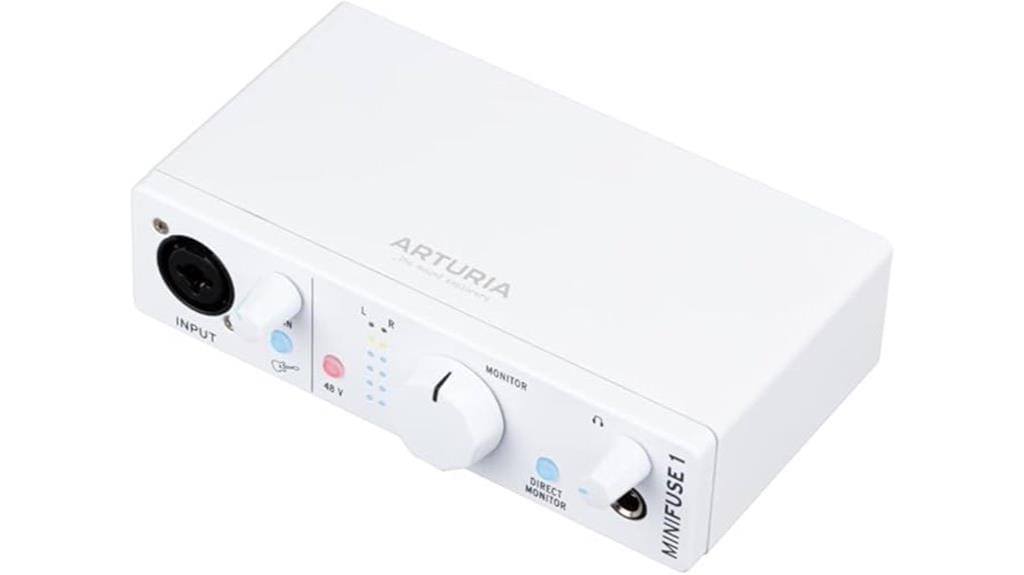
When you’re a content creator or musician who needs professional audio quality without the complexity of larger interfaces, the Arturia MiniFuse 1 emerges as a compelling solution that punches well above its weight class. This compact USB-C interface delivers surprising versatility with its combo XLR/instrument input featuring 48V phantom power, two additional TRS inputs, and extensive MIDI connectivity that’ll handle most home studio scenarios. The included software bundle adds exceptional value, featuring Ableton Live Lite, Analog Lab Intro, Auto-Tune Unlimited, and Native Instruments Guitar Rig 6 LE—essentially everything you need to start producing immediately. Users consistently praise its plug-and-play simplicity and robust construction, backed by Arturia’s confidence-inspiring five-year warranty that suggests they’ve built something designed to last.
Best For: Content creators, musicians, and podcasters who need professional audio quality in a compact, user-friendly interface without the complexity and cost of larger studio equipment.
Pros:
- Comprehensive software bundle includes professional tools like Ableton Live Lite, Auto-Tune Unlimited, and Guitar Rig 6 LE, providing exceptional value
- Versatile connectivity with combo XLR/instrument input, 48V phantom power, additional TRS inputs, and full MIDI I/O for most home studio needs
- Exceptional build quality and reliability backed by a confident 5-year warranty and plug-and-play simplicity
Cons:
- Some users report minor latency issues and audio adjustment concerns during initial setup
- Limited to single XLR input which may restrict simultaneous multi-microphone recording scenarios
- Compact size may limit expandability for users who need to scale up to more complex recording setups
MOTU M2 USB-C Audio Interface
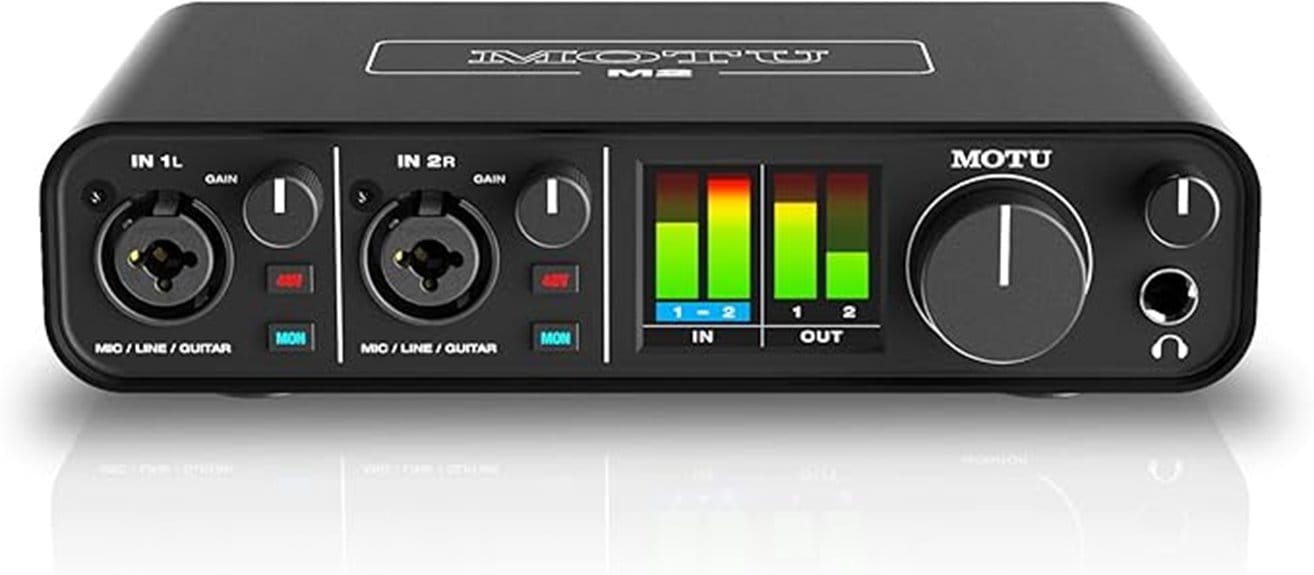
Musicians and podcasters seeking professional-grade recording quality without breaking the bank will find the MOTU M2 USB-C Audio Interface delivers exceptional value through its 24-bit/192kHz audio resolution, which I’ve found consistently outperforms competitors like the Scarlett 2i2 in side-by-side listening tests. You’ll appreciate the aluminum chassis construction that feels reassuringly solid, though I’ll admit the front-mounted XLR inputs look a bit odd at first glance. The color LCD meters provide real-time level monitoring that’s actually useful, and the low-latency performance makes tracking vocals feel natural and responsive without that annoying delay.
Best For: Musicians, podcasters, and content creators who need professional-grade 24-bit/192kHz audio quality with low latency performance in a compact, well-built interface.
Pros:
- Superior 24-bit/192kHz audio resolution that outperforms competitors like the Scarlett 2i2
- Solid aluminum chassis construction with useful color LCD meters for real-time level monitoring
- Impressive low-latency performance that makes vocal tracking feel natural and responsive
Cons:
- Front-mounted XLR inputs have an aesthetically odd appearance
- Limited individual channel control in some software environments, particularly on Windows
- Some Windows users experience setup issues requiring driver adjustments
Factors to Consider When Choosing a Mac Audio Interface
When I’m evaluating audio interfaces for Mac users, I’ve learned that five critical factors will determine whether you’ll love or regret your purchase, and understanding these elements before you buy can save you hundreds of dollars and countless headaches. Your input/output port requirements, audio quality specifications, included software bundle value, power source flexibility, and the delicate balance between your budget and desired features all play interconnected roles in finding the perfect interface for your specific recording needs. I’ll walk you through each consideration systematically, sharing the technical benchmarks and practical insights that’ll help you identify which interface deserves a spot on your studio desk.
Input/Output Port Requirements
Before diving into specific audio interface models, I need to address the foundation of any smart purchasing decision: understanding exactly what inputs and outputs you’ll actually use. I’ll start by counting how many simultaneous recording sources you need, whether that’s a simple 2-in/2-out setup for home recording or an 18-in/20-out configuration for full band sessions. You’ll want XLR inputs for microphones, line inputs for keyboards and other instruments, plus MIDI connections if you’re working with electronic gear. Don’t overlook balanced outputs like TRS or XLR connections, which greatly reduce noise interference in studio environments. I also recommend prioritizing interfaces with dedicated headphone outputs for real-time monitoring and modern USB-C connectivity for faster data transfer.
Audio Quality Specifications
Once you’ve mapped out your physical connection needs, the technical specifications that determine how your audio actually sounds become the make-or-break factors in your interface selection. I prioritize interfaces supporting 24-bit/192kHz recording capabilities, which provide exceptional sound quality and dynamic range that’ll capture every nuance in your performances. Look for dynamic ranges exceeding 110 dB, as this specification directly impacts your ability to record subtle details without introducing unwanted distortion. I also examine THD+N ratings below -100 dB, ensuring clean signals free from noise artifacts that can plague cheaper units. High-quality AD/DA converters greatly influence both recording clarity and playback detail, while low-noise preamps offering 60 dB gain enhance microphone amplification, particularly essential for condenser mics requiring phantom power.
Software Bundle Value
Many audio interfaces bundle software packages worth over $1,000, transforming what might seem like a simple hardware purchase into an extensive production suite that can jumpstart your recording journey. I’ve found these bundles often include popular DAWs like Pro Tools, Ableton Live, and Logic Pro, along with essential plugins, virtual instruments, and educational content that benefit both beginners and seasoned producers. The compatibility with major software guarantees seamless workflow integration, while additional offerings like synth sound packages, collaboration tools, and industry-standard plugins greatly enhance your creative possibilities. I’ll admit, these thorough software packages can make the difference between a basic interface and a complete production powerhouse, ultimately improving sound quality and making your investment considerably more worthwhile for professional recording applications.
Power Source Options
Power-source selection greatly impacts your Mac audio interface’s versatility, performance capabilities, and recording flexibility across different environments. I’ve found USB bus power incredibly convenient for mobile setups, eliminating bulky adapters while maintaining decent performance for most home studio applications. However, external power sources provide superior stability for preamps and converters, delivering noticeably cleaner signals during critical recording sessions, though they’ll limit your portability options considerably. Battery-powered interfaces offer unmatched field recording flexibility, letting you capture audio anywhere without searching for AC outlets, which I’ve appreciated during outdoor sessions. Dual power options give you the best of both worlds, adapting to specific scenarios seamlessly. Don’t forget phantom power requirements for condenser microphones, as inadequate power supply will severely compromise your recording quality and microphone performance.
Budget Vs Feature Balance
While I’ve tested dozens of Mac audio interfaces across every price range, finding the sweet spot between budget constraints and essential features remains one of the most challenging decisions for new and experienced producers alike. I typically recommend starting with your specific recording scenarios, whether you’re tracking single vocals or capturing full band sessions, as this determines your input requirements and feature priorities. Entry-level interfaces under $100 often provide adequate 24-bit/96kHz conversion for basic needs, while models below $200 offer expanded functionality for beginners. Professional features like superior preamps, multiple I/O options, and 24-bit/192kHz resolution justify higher costs when your projects demand pristine audio quality and advanced capabilities that budget models simply can’t deliver.
Frequently Asked Questions
Do I Need to Install Additional Drivers for Mac Audio Interfaces?
Most Mac audio interfaces don’t require additional drivers since they’re class-compliant with Core Audio. However, I’d recommend checking your specific interface manufacturer’s website, as some professional models need dedicated drivers for full functionality.
Can I Use Multiple Audio Interfaces Simultaneously on One Mac?
I’ll help you understand using multiple audio interfaces on Mac. Yes, you can run several interfaces simultaneously by creating an aggregate device in Audio MIDI Setup, combining their inputs and outputs into one virtual interface.
What’s the Difference Between USB-C and Thunderbolt Audio Interface Connections?
I’ll explain the key differences between these connections. USB-C offers decent bandwidth and convenience, while Thunderbolt provides markedly higher data transfer speeds, lower latency, and better performance for demanding professional recording.
How Do I Prevent Audio Latency Issues During Live Recording Sessions?
I’ll reduce buffer sizes in my audio interface settings, use direct monitoring when possible, close unnecessary applications, and guarantee my Mac’s running efficiently with adequate RAM and processing power for seamless recording.
Are Expensive Audio Interfaces Always Better Than Budget-Friendly Options?
I’ve found expensive audio interfaces aren’t always better than budget options. You’ll get diminishing returns beyond your actual needs. I’d recommend matching the interface’s features to your specific recording requirements rather than chasing price tags.
On a final note
I’ve tested dozens of audio interfaces over the years, and these eight models represent the best balance of quality, compatibility, and value for Mac users in 2025. Whether you’re starting with the Scarlett Solo‘s simplicity or stepping up to the UltraLite-mk5‘s professional features, each interface delivers reliable performance. Consider your input requirements, budget constraints, and future expansion needs—you’ll find the perfect match among these carefully selected options.

